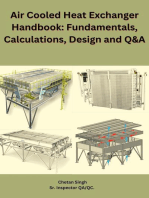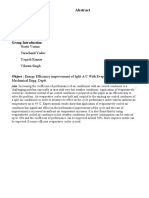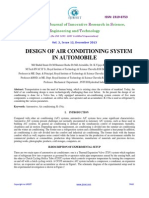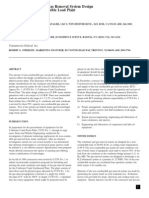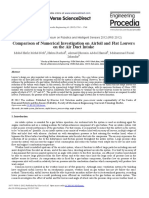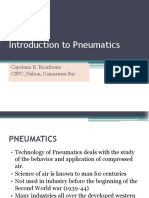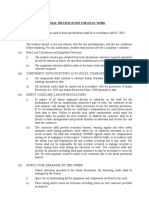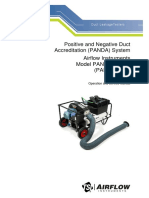Professional Documents
Culture Documents
Mech 3
Mech 3
Uploaded by
cayericaOriginal Description:
Original Title
Copyright
Available Formats
Share this document
Did you find this document useful?
Is this content inappropriate?
Report this DocumentCopyright:
Available Formats
Mech 3
Mech 3
Uploaded by
cayericaCopyright:
Available Formats
Duct Design using equal friction method & CFD
Raviraj Gurav 1 Sanjay Gaikwad 2 Pritee Purohit 3
1,2,3 Assistant Professor ,Army Institute of Technology, Pune-15
1.guravraviraj1@gmail.com
2.gaikwads_sanjay@rediffmail.com
3. priteepurohit@gmail.com
ABSTRACT:
Earlier the use of air-conditioning for comfort
purpose was considered a luxurious but now-a-day, it
has been a necessity in extreme climatic conditions,
such as extreme cold and hot in western countries.
Window air conditioners are preferred for office
rooms while large centralized units are installed for
conditioning the auditorium, hospitals etc. The
correct estimation of cooling load of an auditorium is
very complicated due to many factors such as
outdoor temperature, humidity, air leakage into the
conditioned space, occupants, quantity of fresh air
taken in and solar load etc. The authors have
calculated cooling load, quantity of supply air (in
cmm) of an auditorium using CLTD method which is
more accurate. Equal friction method is adopted to
design the duct which is simple as compared with the
other duct design methods . Using CFD software,
analysis of air flow considering velocity and pressure
is done in main duct and in elbow. The authors
concluded that the combine effect of proper duct
design method & CFD could be used to achieve
proper air distribution inside the auditorium with
minimum pressure loss, running cost & energy
consumption have calculated cooling load, quantity
of supply air (in cmm) of an auditorium using CLTD
method which is more accurate. Equal friction
method is adopted to design the duct which is simple
as compared with the other duct design methods .
Using CFD software, analysis of air flow considering
velocity and pressure is done in main duct and in
elbow. The authors concluded that the combine effect
of proper duct design method & CFD could be used
to achieve proper air distribution inside the
auditorium with minimum pressure loss, running cost
& energy consumption
Keywords- duct ,equal friction, CLTD,Cooling Load,CFD
INTRODUCTION
Without A/C system, person working in industry is
feeling unhealthy, uncomfortable and inefficient. In
order to achieve required cooling load, proper
method is required. Proper air distribution is achieved
with proper duct design which leads minimum losses
in the system, suitable selection of fan with high
efficiency, optimum air velocity in duct, inlet and
outlet of fan. Today some softwares are available to
estimate cooling load, to design the duct, to select the
fan etc. Life has become easier due to AUTOCAD
software to draw plant layout. CFD as a analysis tool
has the ability to establish firm quantitative data
regarding air motion and can predict fluid
characteristics and pressure differentials to a very low
level that are experimentally impossible during
experimentation. Analysis of air flow in duct with
static pressure and velocity pressure is made easier
and faster in Fluent software. The requirement of air
conditioner is that it must provide adequate cooling
to the occupants in the conditioned space under a
wide variety of ambient conditions. A normal healthy
person feels comfortable at 25C DBT, 50% RH with
9 to 12m/min air velocity. Human comfort is
influenced with the physiological conditions
determined by the internal heat generation.
Large number of researchers have worked on duct
design with various methods. The contribution of
various researchers on the topics is briefed as
follows.
1. design for high velocity duct system is done by
determining the pressure losses, calculating the noise
level, determining the out of balance pressures &
optimizing this against the total cost of the system.
2. VAV optimization procedure was applied to the
three VAV duct systems to investigate the impact of
varying airflow rates on the sizing of duct systems.
For comparison purposes, other duct design methods,
such as, equal friction, static regain, and the TMethod, were also applied to the duct systems.
3. Design optimization of industrial ducts is achieved
with CFD. The CFD analysis has offered a
comprehensive range of output including velocity
distribution, pressure profiles and turbulence levels
The main purpose of this paper is make proper
calculation of cooling load, supply air quantity using
proper method , decide size of main duct & elbow
using proper duct design method so person seating in
the auditorium can feel comfortable .
THEORY
Cooling Load Temperature Differential
(CLTD) / Cooling Load Factors (CLF) / Solar
Cooling Load (SCL) is used to calculate the cooling
load of an auditorium. It was an attempt to simplify
two steps TFM & TETD /TA methods into a single
step technique that allowed proceeding directly from
raw data to cooling load. A series of factors were
Mech | 1
taken from cooling load calculation results as
Equivalent Temperature Difference for use in
traditional condition ( q = UA dT) equation. The
conditioned air (cooled or heated) from the air
conditioning equipment must be properly distributed
to rooms or spaces to be conditioned in order to
provide comfort conditions. When the conditioned
air cannot be supplied directly from the air
conditioning equipment to the spaces to be
conditioned, then the ducts are installed. The duct
systems convey the conditioned air from air
Duct material is usually made from galvanized iron
sheet metal, Al sheet metal or black steel. But now a
day, the use of non-metal ducts has increased. The
resin bonded glass fiber ducts are used because they
are quite strong and easy to manufacture according to
desired shape and size. They are used in low velocity
applications less than 600m/min and for static
pressures below 5mm of water gauge.
It may be made in circular, rectangular or
square shapes. From an economical point of view, the
circular ducts are preferred because the circular shape
can carry more air in less space. This means that, less
duct material, less duct surface friction and less
insulation is needed. For rectangular duct, shape is
determined considering minimum aspect ratio.
Calculation of static pressure, dynamic pressure &
total pressure in duct is important. The pressure in
duct is usually expressed in mm of water. Rise in
pressure in fan is known as fan total pressure( FTP).
FTP & supply air flow rate (in cmm) are used to
select the fan. Here the pressure is lost due to friction
between the moving particles of fluid (i.e. air) and
interior surface of duct. When the pressure loss
occurs in a straight duct, it is usually termed as
friction loss. The pressure is also lost dynamically at
the changes of direction such as in bends, elbows etc.
and the changes of cross section of duct; this type of
pressure loss is usually termed as dynamic loss.
GENERAL RULES USED TO DESIGN AIRDUCT:
i) Air should be conveyed as directly as possible to
economize on power, material and space.
ii) Sudden changes in direction should be avoided.
When bends are essential, turning vanes should be
used to minimize pressure loss.
iii) Air velocities in ducts should be within
permissible limits to minimize noise.
iv) Diverging sections should be made gradual. The
angle of divergence should not exceed 200.
v) Rectangular ducts should be made as nearly
square as possible. This will insure minimum duct
surface, and hence cost, for the same air carrying
capacity. Dampers should be provided in each branch
outlet for balancing the system.
vi) Avoid duct obstructions
METHODS OF DUCT DESIGN:
i) Equal Friction Method
conditioning equipment to proper air distribution
points or air supply outlets in the room and carry the
return air from the room back to the air conditioning
equipment for reconditioning and recirculation. The
conditioned air (cooled or heated) from the air
conditioning equipment must be properly distributed
to rooms or spaces to be conditioned in order to
provide comfort conditions. It may be noted that
duct system for proper distribution of conditioned air
cost nearly 20 to 30 % of total cost of equipments
required
ii) Velocity Reduction Method
iii) Static Regain Method
In Equal Friction Method the frictional pressure drop
per unit length of the duct is maintained constant
throughout the duct system. Due to its simplicity, this
method is used in the thesis to design the duct.
Cooling Load Calculation for an Auditorium:
Data collected for an existing auditorium, Pune
1.
No. of doors
2. No. of windows
: 9
1
Entry and exit.
Back stage.
: 8
3. No. of Chairs:
Dress circle
704
Balcony
202
Total
906
4. Equipments : Total item having 11.78 KW
DESIGN CONDITIONS
1. Latitude of Pune
: 186 North.
2. Design Day
: 25th May.
(Max. temperature during last week of may, from last
5 years data.)
3. Outside conditions
: DBT = 38 C
(Outdoor)
RH= 50%
4. Indoor conditions
: DBT = 22
RH= 55%
5. Daily range (DR)
: 10
6. Time
: 4:00 pm
7. Average outside temperature on design day
Ta= To - (DR/2)= 38 - (10/2) = 91.6 F
TOTAL COOLING LOAD
Total = QS + QL = 2.55 + 4.54 = 7.09 kW
Total sensible load on cooling coil = 248132.64 W
Total latent load on cooling coil = 276989.83 W
Therefore, Total cooling coil load = 525122.47 W
Therefore,Refrigeration load =525.122/3.516=150TR
Safety factor of 5% due to duct heat gain
Therefore,
Cooling load = 157.5 TR 160 TR
Mech | 2
Fig.1 Air distribution system & air flow rate
Assuming by-pass factor (BPF) 0.15 , mass flow rate
is calculated. Mass flow rate of air, ms = 19.28 kg/s
(cmm)s = 1288.88 1290
CALCULATION OF FRICTION LOSS IN
DUCT & DUCT DIAMETER
Rearranging fanning equation, Colebrook-White
relation & Fritzsche relation
Pf = ( 0 .01422 C 1.852 L ) / D 1.269
Pf = (0.002268 Qv1.852 L) / D4.973 mm of H20
Pf = (0.012199 C 2.4865 L) / Qv0.6343 N/m2
Recommended velocity in duct for auditorium, C =
6.5 m/ s or 390 mpm
.So, Pf / L = 0.36629 N/m2 /m
= 0.03669 mmH2O /m 0.04 mmH2O/m
0.04 in w. /100 ft
(In industry standard value for pressure loss = 0.1
in.w./100 ft. = 0.846 N/m2 /m)
Circular Duct Diameter = 1.187 m
For rectangular duct dimension, minimum aspect
ratio 1.3 is taken. a/b = 1.3 ( a= width, b= height)
( it should be kept as low as possible to keep friction
losses reasonably low and thereby avoid excess
energy consumption.)
D = 1.265 (a * b) 0.6 / (a + b) 0.2
Large dimension(a)=1.24 m & small dimension(b) =
0.9543 m
Fig.2 : Pressure variation in a Duct System:
Fan Total Pressure = 45.47 mm H2O = 446 N / m2
Fan Static Pressure= 359.49 N / m2 = 1.42 H2O
DUCT DESIGN USING EQUAL FRICTION
METHOD
First measurement of all dimensions are done for
auditorium and with AUTOCAD software, drawings
are made (front view and top view). It is shown
below
In the equal friction method, the frictional
pressure drop per unit length of the duct is
maintained constant throughout the duct system. The
procedure is to select a suitable velocity in the main
duct from sound level considerations. Knowing the
air flow rate and the velocity in the main duct, the
size and friction loss are determined from the friction
chart. The remaining ducts are then sized maintaining
the friction loss per unit length at this value for their
respective air-flow rates.
Due to 3 fans in the system, there will be 3 main
supply ducts. The air supply from three main ducts
goes to three different areas
i) First main duct balcony and remaining area
(excluding stage) of one side
ii) Second main duct - balcony and remaining area
(excluding stage) of other side
iii) Third main duct - stage
Mech | 3
Layout of First Main Duct (Supply Duct)
Flow rate = 15524 CFM = 7.2 m3 / s,
Pf = 0.04 mm H2O /m = 0.4 N /m2/m
Fig. 3: Layout of First Main Duct (Supply Duct)
Fig.6: Analysis of Elbow considering inlet Velocity
Fig 4: Layout of Branch A of First Main Duct (Supply
Duct)
Branch A
From main duct to first supply outlet, Flow rate = 2.5
m3 / s = 5390 CFM
Pf = 0.04 mm H2O /m = 0.4 N /m2/m
Recommended branch duct Velocity = 4.5 m/s
So from friction chart of duct
Diameter of duct = D = 32" = 0.8128 m
For rectangular duct, a / b = 1.3
D=1.3(a*b)0.625/(a+b)0.25
From this equation, we get a = 0.85 m b= 0.65 m
CFD Analysis:
Duct design is done using equal friction method.
For CFD analysis, Fluent 6.1 software is used.
Gambit 2.0 is used for modeling the main duct and
elbow. Geometry and meshing is carefully done in
Gambit. Pressure and velocity variations are observed
in this analysis. Eddies observed in elbow are due to
improper shape and velocity. All figures from
geometry, boundary condition to eddy are given here.
This CFD tool can be used for a whole building to
analyze air pressure and velocity fluctuation in all
ducts
Fig.5:Analysis of Duct considering Inlet Velocity
RESULT ANALYSIS
The result analysis is based on duct design of
auditorium and existing plant. Comparison among
these plants can be made with some points.
I) Duct size: To design the duct in an auditorium
calculation of cooling load and air flow rate is done.
By assuming suitable air velocity (from 1967 systems
and equipment ASHRAE Handbook) considering
noise factor, calculation of main duct is done. Then
size of rectangular duct is calculated considering
minimum aspect ratio.
So maximum care is taken to apply standard rules to
design the system. Variation occurred in some points
are given below
Sr. Points
No.
1
Capacity
of plant
Ducts
Plant 1
Plant 2
Auditorium
100 TR
100 TR
160 TR
Three main
One main
Three main
ducts
ducts
ducts
1.24m *
Main
1.2 m* 0.9
1.62 m *
Duct size
1.21m
0.95m
II) Branch ducting:
Branch connection with low pressure are used.
III) Equal friction method is used in industry or in
existing design or in an auditorium. But equal
frictional pressure drop used in industry is 0.1
in.w./100ft. or 0.846 N/m2/m. while designing of an
auditorium, 0.04 in. w / 100 ft. or 0.4 N/m2/m is used.
Practical knowledge is very important to study and
make some conclusion about this point.
IV) Aspect Ratio: It is kept minimum in each design
V) CFD Analysis: It is a new tool which is applied to
observe air motion through straight duct and elbow.
Also it can be applied for all ducting in a building.
Due to improper shape and velocity, eddies are
observed in elbow with CFD analysis. so by proper
shape , eddies are minimized. Analysis of all ducting
Mech | 4
and fan will reduce pressure loss, noise and obviously
It saves time and cost. So CFD is best tool for HVAC
system
CONCLUSION:
The following conclusions summarize
experimental results presented in this paper
the
1)The cooling load calculation of an auditorium is
done, applying CLTD method and duct design is
carried out by equal friction method. All results are
comparable with existing plant.
1)
3)
2)The calculated value of frictional pressure drop is
less as compared to existing plant or value used in
industry. Due to less value, duct diameter is
increased but loss in static pressure, velocity pressure
can be avoided. Smaller diameter of duct would
increase noise level. So requirement of sound
attenuating devices may need. Also probability of
dampers is decreased with increasing diameter. But
first cost is increased with increasing duct diameter.
2) Due to proper branching (with elbow) of ducts, loss
is minimized in this design. But in existing plant,
there is straight branching in so many locations,
which may increase the pressure loss.
Aspect ratio is kept minimum in this design. So
friction loss and excess energy consumption is
decreased
4) Pressure loss in duct fitting is kept minimum by
using elbow with proper shape considering very less
pressure loss coefficient.
6)CFD software is used to analyze the air flow in
straight duct and in elbow. Eddies are observed due
to incorrect shape of elbow. So proper shape of
elbow and correct velocity are estimated to minimize
the eddies as well as pressure loss.
7)CFD can be used to study pressure and velocity
fluctuation for a whole building. So it is a better tool
which can be used in HVAC system to save time and
cost
ACKNOWLEDGEMENT
Valuable information & layout of plant 1& 2 is
taken from existing central air-conditioning plant in
Pune.
REFERENCES
1. Signato,J.J.W., A High Velocity, Low Pressure
Air System, ASHRAE Transactions ,1980, Part I ,
PP.180-200
2 Kim, Taecheol.,and Spitler, J.D.,Optimization of
VAV Duct System, ASHRAE transactions 2002,
vol.108, part-I, pp. 96-104.
3 Small,Mauro.,Non-Iterative
Technique
for
Balancing an Air Distribution System Thesis of
Master of Science, Feb.2002 ,pp.1-40.
4 Dr. Ghate., K,Sudhakar., and Majumdar,P.M., 3D Duct Design Using Variable Fidelity Method
CASDE, Powai , Mumbai, pp.1-11.
Mech | 5
Mech | 6
Mech | 7
You might also like
- HVAC Master Validation PlanDocument51 pagesHVAC Master Validation Plannavas197294% (31)
- Air Cooled Heat Exchanger Handbook: Fundamentals, Calculations, Design and Q&AFrom EverandAir Cooled Heat Exchanger Handbook: Fundamentals, Calculations, Design and Q&ANo ratings yet
- ACMV CalculationDocument12 pagesACMV Calculationazim azrulNo ratings yet
- Computation 03 00128 PDFDocument22 pagesComputation 03 00128 PDFHarjinder SInghNo ratings yet
- The Specific Objectives of This Chapter Are To:: 38.2 - General Rules For Duct DesignDocument6 pagesThe Specific Objectives of This Chapter Are To:: 38.2 - General Rules For Duct DesignSalehAfadlehNo ratings yet
- Design of Air Conditioning Ducts: LessonDocument20 pagesDesign of Air Conditioning Ducts: LessonAkhileshkumar PandeyNo ratings yet
- 38 Design of Air Conditioning DuctsDocument20 pages38 Design of Air Conditioning Ductsteo1285No ratings yet
- Heating and Cooling Load CalculationDocument7 pagesHeating and Cooling Load Calculationirsalan_shahidNo ratings yet
- Simplified Numerical Model For A Flat Continuous Triangle Fins Air Cooled Heat Exchanger Using A Step by Step TechniqueDocument23 pagesSimplified Numerical Model For A Flat Continuous Triangle Fins Air Cooled Heat Exchanger Using A Step by Step TechniquemunkkkkNo ratings yet
- R - AC Lecture 38Document22 pagesR - AC Lecture 38Narulita B. PutriNo ratings yet
- Optimized Location of Air-Conditioning Unit Inside Office Room To Obtain Good Thermal ComfortDocument6 pagesOptimized Location of Air-Conditioning Unit Inside Office Room To Obtain Good Thermal ComfortKVSRIT Dept. of MENo ratings yet
- Thermal Analysis of Indoor SubstationDocument8 pagesThermal Analysis of Indoor SubstationEnriqueGD100% (1)
- Case Studies in Thermal Engineering: Anan Tempiam, Pongsakorn Kachapongkun, Phadungsak Rattanadecho, Ratthasak PrommasDocument11 pagesCase Studies in Thermal Engineering: Anan Tempiam, Pongsakorn Kachapongkun, Phadungsak Rattanadecho, Ratthasak PrommasAnbarasan RaviNo ratings yet
- Research Paper HvacDocument6 pagesResearch Paper Hvacgw2x60nw100% (1)
- Thermal Mini Project ReportDocument23 pagesThermal Mini Project Reportmuhammad irfan hakimi bin nor yazidNo ratings yet
- Tzempelikos D. Et Al - Airflow Patterns in A Laboratory Batch-Type, Tray Air Dryer - Ic-Scce2012 - ProceedingsDocument10 pagesTzempelikos D. Et Al - Airflow Patterns in A Laboratory Batch-Type, Tray Air Dryer - Ic-Scce2012 - ProceedingsAndronikos FiliosNo ratings yet
- Design of Air Conditioning DuctsDocument15 pagesDesign of Air Conditioning Ductsabidch143No ratings yet
- Project Standard and Specifications Compressed Air Systems Rev01Document19 pagesProject Standard and Specifications Compressed Air Systems Rev01авдей александр0% (1)
- Design of Air Conditioning DuctsDocument37 pagesDesign of Air Conditioning Ductsandu gashuNo ratings yet
- Mr. Dinesh Sharma Mr. Hansraj Prajapati Neetu Verma Tarachand Yadav Yogesh Kumar Vikram SinghDocument7 pagesMr. Dinesh Sharma Mr. Hansraj Prajapati Neetu Verma Tarachand Yadav Yogesh Kumar Vikram SinghAnkush KhokharNo ratings yet
- Air Distribution System Equipment's and Duct DesignDocument36 pagesAir Distribution System Equipment's and Duct DesignfekadeNo ratings yet
- Yin Hua Guo Huafang, Lin Zhenrong, Zeng BoDocument7 pagesYin Hua Guo Huafang, Lin Zhenrong, Zeng BoNajaf HussainNo ratings yet
- ENCIT 2014 - Altea, YanagiharaDocument8 pagesENCIT 2014 - Altea, YanagiharaLeandro SalvianoNo ratings yet
- Air Conditioning System Design 4th Chapter Two Air Duct Design 2020Document60 pagesAir Conditioning System Design 4th Chapter Two Air Duct Design 2020adda adqwNo ratings yet
- Flow and Thermal Analysis On The FUMEX: 2) Fumex & Domex Exhaust FansDocument5 pagesFlow and Thermal Analysis On The FUMEX: 2) Fumex & Domex Exhaust FanslukhmanNo ratings yet
- Optimization of Air Preheater Design For The Enhancement of Heat Transfer CoefficientDocument10 pagesOptimization of Air Preheater Design For The Enhancement of Heat Transfer CoefficientVijay KumarNo ratings yet
- Duct Design - Equal Friction MethodDocument35 pagesDuct Design - Equal Friction MethodAdhitya DarmadiNo ratings yet
- 11 - Energy-Efficient Operation Strategy For Air CompressorDocument8 pages11 - Energy-Efficient Operation Strategy For Air CompressorAbdallah AbdallahNo ratings yet
- Equipment and Systems - HVAC and Refrigeration PE Exam Tools - Mechanical PE Sample Exams, Technical Study Guides and ToolsDocument35 pagesEquipment and Systems - HVAC and Refrigeration PE Exam Tools - Mechanical PE Sample Exams, Technical Study Guides and ToolsFaquruddin AliNo ratings yet
- A Thermodynamic Study of Air Cycle Machine For AerDocument10 pagesA Thermodynamic Study of Air Cycle Machine For AerEmandi RajeshNo ratings yet
- Design of A Modern Subway Ventilation SystemDocument4 pagesDesign of A Modern Subway Ventilation Systemjerry666a100% (1)
- HVAC Course PreviewDocument8 pagesHVAC Course PreviewMohammed MechNo ratings yet
- Ijaiem 2013 09 29 077Document3 pagesIjaiem 2013 09 29 077Asok AyyappanNo ratings yet
- Improvement in The Performance of Cooling Tower of Thermal Power PlantDocument4 pagesImprovement in The Performance of Cooling Tower of Thermal Power PlantVetihiNo ratings yet
- RefrigerationDocument6 pagesRefrigerationMd. Hasibul HasanNo ratings yet
- CFD Analysis of Solar Flat Plate CollectorDocument6 pagesCFD Analysis of Solar Flat Plate CollectorDimuthu Prasad WijethungeNo ratings yet
- Icme05 FL 24Document5 pagesIcme05 FL 24gauravglittersNo ratings yet
- Hvac DissertationDocument4 pagesHvac DissertationWriteMyPaperForMeFastSingapore100% (1)
- For Summer COolingDocument4 pagesFor Summer COolingBoris Joshua Q. TeodoroNo ratings yet
- Multivariable Control-Oriented Modeling of A DirectDocument9 pagesMultivariable Control-Oriented Modeling of A DirectEva ViskadourakiNo ratings yet
- Interference Effects of Cooling Air-Flows With External AerodynamicsDocument7 pagesInterference Effects of Cooling Air-Flows With External AerodynamicsVyssion100% (1)
- Design of Hvac System For Beverage IndustryDocument12 pagesDesign of Hvac System For Beverage IndustryKorn KcNo ratings yet
- Performance Analysis in Off Design Condition of Gas Trbine Air Bottoming Combined SystemDocument10 pagesPerformance Analysis in Off Design Condition of Gas Trbine Air Bottoming Combined SystemIrving Rosas JovenNo ratings yet
- Performance Evaluation of A Air Conditioner According To Different Test Standards PDFDocument9 pagesPerformance Evaluation of A Air Conditioner According To Different Test Standards PDFIAEME PublicationNo ratings yet
- Chapter 4Document33 pagesChapter 4fekadeNo ratings yet
- System of Compressed Air For Electrofilter in Thermal Power PlantDocument4 pagesSystem of Compressed Air For Electrofilter in Thermal Power PlantAmit JainNo ratings yet
- Thermal Comfort Conditions at Airport 1Document3 pagesThermal Comfort Conditions at Airport 1Kashaf sayedNo ratings yet
- Ijmet: ©iaemeDocument8 pagesIjmet: ©iaemeIAEME PublicationNo ratings yet
- Using Evaporative Cooling Methods For Improving PeDocument14 pagesUsing Evaporative Cooling Methods For Improving PeDiaa GobranNo ratings yet
- Design of Air Conditioning System in AutomobileDocument5 pagesDesign of Air Conditioning System in AutomobilemhdmkNo ratings yet
- Condenser and Hybrid Gas Removal System Design For A High Non-Condensible Load PlantDocument4 pagesCondenser and Hybrid Gas Removal System Design For A High Non-Condensible Load PlantAgustin A.No ratings yet
- 10 - Air Distribution SystemDocument7 pages10 - Air Distribution SystemZeeshan HasanNo ratings yet
- CFD-01-Air Flow Study Inside The Supermarket HussmannDocument9 pagesCFD-01-Air Flow Study Inside The Supermarket Hussmanndevinder_bamrahNo ratings yet
- Cold Air Distribution Design ManualDocument67 pagesCold Air Distribution Design ManualMohammed Jassim100% (2)
- Ductwork SizingDocument11 pagesDuctwork SizingRexhep SelimajNo ratings yet
- Comparison of Numerical Investigation On Airfoil and Flat Louvers On The Air Duct IntakeDocument8 pagesComparison of Numerical Investigation On Airfoil and Flat Louvers On The Air Duct IntakeClinton InfantNo ratings yet
- Hvac Thesis TopicsDocument5 pagesHvac Thesis Topicsgj3vfex5100% (2)
- Spatial Distribution of Air Temperature and Air Flow Analysis in Radiant Cooling System Using CFD Technique - ScienceDirectDocument13 pagesSpatial Distribution of Air Temperature and Air Flow Analysis in Radiant Cooling System Using CFD Technique - ScienceDirectMUKUL KHARVANo ratings yet
- The Handbook of Heating, Ventilation and Air Conditioning (HVAC) for Design and ImplementationFrom EverandThe Handbook of Heating, Ventilation and Air Conditioning (HVAC) for Design and ImplementationRating: 1 out of 5 stars1/5 (1)
- Air-Cooled Condenser Fundamentals: Design, Operations, Troubleshooting, Maintenance, and Q&AFrom EverandAir-Cooled Condenser Fundamentals: Design, Operations, Troubleshooting, Maintenance, and Q&ARating: 5 out of 5 stars5/5 (1)
- Temperature and Humidity Independent Control (THIC) of Air-conditioning SystemFrom EverandTemperature and Humidity Independent Control (THIC) of Air-conditioning SystemNo ratings yet
- Assignment Questions: Course: Computing Applications For Mechanical Systems (MEEN-561)Document26 pagesAssignment Questions: Course: Computing Applications For Mechanical Systems (MEEN-561)cayericaNo ratings yet
- Theory of Machines I: Laboratory ManualDocument99 pagesTheory of Machines I: Laboratory ManualcayericaNo ratings yet
- Phyc 500: Introduction To Labview Exercise 4 (V 1.2) : For LoopDocument4 pagesPhyc 500: Introduction To Labview Exercise 4 (V 1.2) : For LoopcayericaNo ratings yet
- PC PLC Based Multi Process Control System TrainerDocument3 pagesPC PLC Based Multi Process Control System TrainercayericaNo ratings yet
- Word Processing: What We'll Cover For This Lecture TopicDocument15 pagesWord Processing: What We'll Cover For This Lecture TopiccayericaNo ratings yet
- Pascal Programming: Complex Array StructuresDocument9 pagesPascal Programming: Complex Array StructurescayericaNo ratings yet
- CH 12Document10 pagesCH 12cayericaNo ratings yet
- Supply and Installation of Delta DOP Human Machine Interface SystemDocument2 pagesSupply and Installation of Delta DOP Human Machine Interface SystemcayericaNo ratings yet
- Exp2B ProjectileMotion DigitalDocument9 pagesExp2B ProjectileMotion DigitalcayericaNo ratings yet
- Introduction To PneumaticsDocument14 pagesIntroduction To PneumaticscayericaNo ratings yet
- MATLAB Tutorial: G(S) U(s) Input Y(s) OutputDocument25 pagesMATLAB Tutorial: G(S) U(s) Input Y(s) OutputcayericaNo ratings yet
- Child Protection in The PhilippinesDocument86 pagesChild Protection in The PhilippinesMheyRamaNo ratings yet
- TIP SHEETS - Fire-Stopping & Fire-Sealing - WWW - TrivalueconsultantsDocument5 pagesTIP SHEETS - Fire-Stopping & Fire-Sealing - WWW - TrivalueconsultantsTri-Value ConsultantsNo ratings yet
- Technical Data PRIHODADocument32 pagesTechnical Data PRIHODAAlex PotaNo ratings yet
- Homologacion Z-20.1-17 Permanent Bar AnchorsDocument25 pagesHomologacion Z-20.1-17 Permanent Bar AnchorsAnonymous hHWOMl4FvNo ratings yet
- MAA Refinery - Daelim - Training - I&CDocument106 pagesMAA Refinery - Daelim - Training - I&Cbezzel100% (1)
- Variable Air Volume: HVAC System BasicsDocument10 pagesVariable Air Volume: HVAC System Basicsdexture harddriveNo ratings yet
- ApartmentDocument15 pagesApartmentJeanne Belmonte100% (1)
- 2019 CMCDocument550 pages2019 CMCTony OquendoNo ratings yet
- AABC Specifications For Testing and Balancing HVAC Systems: Revised February 2007Document11 pagesAABC Specifications For Testing and Balancing HVAC Systems: Revised February 2007sreejeshkeralamNo ratings yet
- Catalogue 2005Document42 pagesCatalogue 2005stanjack99No ratings yet
- Typical Fcu Connections: ProposedDocument1 pageTypical Fcu Connections: ProposedIbrahim FarhanNo ratings yet
- Hvac Systems: Corrosion Protection SolutionsDocument10 pagesHvac Systems: Corrosion Protection SolutionsDejan LazarevicNo ratings yet
- ICD CatalogDocument8 pagesICD CatalogSteven HungNo ratings yet
- Sensor Price List 2020 PDFDocument31 pagesSensor Price List 2020 PDFSyed Rohail AhmedNo ratings yet
- Pre-Functinal Checks FormatDocument15 pagesPre-Functinal Checks Formatchakravarthi kanugulaNo ratings yet
- BP090&120 50 HZ TechDocument24 pagesBP090&120 50 HZ Techmauricio.vidalyork6735No ratings yet
- Sound Ratings & ARI StandardDocument4 pagesSound Ratings & ARI StandardPrasad GujarNo ratings yet
- DT 6000Document18 pagesDT 6000Mahmood EijazNo ratings yet
- Ceiling Concealed - Daikin Drain Installation ManualpdfDocument3 pagesCeiling Concealed - Daikin Drain Installation ManualpdfJohnNo ratings yet
- HVACwork3L3L3 PDFDocument69 pagesHVACwork3L3L3 PDFZeeshan HasanNo ratings yet
- Prefunctional Checklists-AddendaDocument36 pagesPrefunctional Checklists-AddendaMouayed ZeadanNo ratings yet
- GBI MS1525-2007 Energy Management SystemDocument87 pagesGBI MS1525-2007 Energy Management Systempuiying80100% (1)
- Sheet Metal Worker Level 2: Rev. September 2009Document16 pagesSheet Metal Worker Level 2: Rev. September 2009Brennen WilsonNo ratings yet
- HCD Series: High Capacity Drum LouversDocument8 pagesHCD Series: High Capacity Drum LouversElvis Ruben Piza MerchanNo ratings yet
- Procured List PDFDocument41 pagesProcured List PDFnaveen_1507No ratings yet
- Duoflex Kiln BurnerDocument37 pagesDuoflex Kiln BurnerThaigroup Cement100% (1)
- Healthcare Facilities Fire Protection Design ManualDocument49 pagesHealthcare Facilities Fire Protection Design Manualhafizqays100% (5)
- Tsi Panda 341 User ManualDocument37 pagesTsi Panda 341 User Manuala k bNo ratings yet
- This Paper Elaborates On The Various Methods of Cable Laying and The Advantages and Disadvantages of The SameDocument15 pagesThis Paper Elaborates On The Various Methods of Cable Laying and The Advantages and Disadvantages of The SamesamsungloverNo ratings yet

